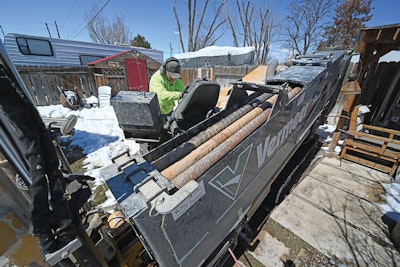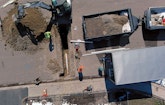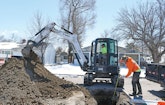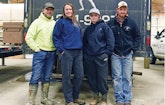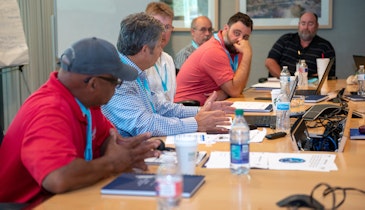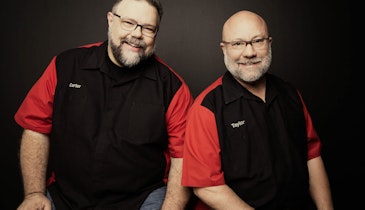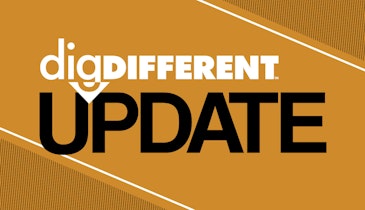
JD and Tana Christensen opened Platinum Plumbing as a small plumbing business in 2007, but have since expanded to offer directional drilling and excavation services (mini-excavator from Bobcat).
Interested in Drilling?
Get Drilling articles, news and videos right in your inbox! Sign up now.
Drilling + Get AlertsJD and Tana Christensen never intended to do horizontal directional drilling when they founded Platinum Plumbing in Pocatello, Idaho, in 2007.
But the fact that directional drilling now generates the majority of the company’s revenue underscores the value of pivoting to new markets when opportunity knocks and diversifying services. It also reflects the importance of taking calculated business risks and being the first to invest in advanced technology — such as directional drilling machines and a pipe bursting system — to enter emerging markets.
“It was a big-gulp moment,” says Tana Christensen about the roughly $40,000 the company, which does business as Platinum Directional Drilling, spent on a Vermeer D7x11 HDD machine from Vermeer Corp., plus another $45,000 or so for a Vermeer mud-mixing machine and a flatbed trailer.
“We were into it for around $85,000 all told,” she continues. “It took a huge leap of faith. But JD had every confidence that it would work out. And it did.”
Today, directional drilling generates about 65% of the company’s revenue, excavation and pipe-bursting contribute around 20%, and plumbing service and repair work contributes the rest. The company’s primary services are drilling boreholes for new residential water-service lines, pipe bursting to install new residential sewer laterals and small plumbing repairs.
“The only reason we still do small-service plumbing is to stay busy on slower days, especially in winter,” Tana Christensen says. “It’s nice to keep some cash flow going.”
PLUMBING CAME FIRST
Directional drilling was not even a microscopic blip on the Christensens’ radar when they established Platinum Plumbing, so-named because platinum — a dense metal with a high melting point — represents something valued, rare and tough, she explains.
JD got into the plumbing field because he had family in the industry and enjoyed the constant variety and the physical aspects of the work. After he graduated from high school, JD worked for a plumbing company in Pocatello, where he completed his apprenticeship.
Looking for a change of scenery after working for that company for six years and earning his journeyman’s and contractor’s license, JD left the plumbing field altogether to avoid competing with his former employee. Instead, he embraced the home-construction trade and then became a state plumbing inspector — the youngest one in the state at the time, she says.
“But he hated it — didn’t like the office work,” Tana Christensen says. So JD went back to home construction before eventually founding Platinum Plumbing.
“It was very scary because we didn’t know anything about starting, owning or running a business,” Tana Christensen says. “We did a lot of reading and talking to other business owners who were willing to share information. The Southeast Idaho Small Business Development Center also was very helpful.”
Things started out slow and small, with about 75 jobs the first year, mostly small repairs obtained through word-of-mouth references from family and friends. JD did some rough-in and trim-out plumbing for new-home builders, but soon stopped doing that because it was so time-consuming he couldn’t do the kind of small service and repair jobs needed to build a business, she says.
“We were trying to grow a customer base through service work, so being available to do that kind of work was a big deal,” she notes.
HEADING UNDERGROUND
The company pivoted to directional drilling in 2012 when a customer asked if there was a way to replace a leaking water-service line without disrupting his well-manicured front yard. JD then saw a contractor using a directional drill to install a fiber-optic line.
“He asked the contractor if he could hire him to drill a new water-service line,” Tana Christensen says. “He agreed to do it and it worked very well. And JD went out and bought a Vermeer directional drill.”
Learning how to use the machine required a “huge” learning curve that included lots of reading, watching YouTube videos and trial and error, she says.
“A month or two after buying it, we lost a 16-inch reamer and four rods in sandy soil in an area north of Pocatello,” JD Christensen recalls. “The next day we lost a drill head under a garage at a home in Pocatello, about 8 feet underground. Thankfully, we had everything insured and the insurer came through.”
NO TURNING BACK
At that point, a discouraged Tana wanted to quit, but JD declined, noting the company had too much money invested to turn back.
“Quit just isn’t in JD’s vocabulary,” she says. “You can’t be risk-averse and succeed in this business.”
The takeaways from the experience? Success requires a lot of grit, faith and perseverance, Tana Christensen notes.
“And you need good business insurance,” she adds.
An invaluable employee — Zach Hall — also contributes greatly to the company’s growth and success, Tana Christensen says.
“Zach has been pivotal in our growth,” she says. “He is a stellar employee that we are extraordinarily lucky to have. He has grown, changed and emerged with us into the business we are today.
“That wouldn’t be an easy ask for anyone, but he’s done it with the same faith and confidence that we’ve put into the business since the beginning.”
GAINING TRACTION
Slowly but surely, the company established a customer base. One key to success was being the first business in southeast Idaho to own a directional drill as well as the only one to own one for quite a while. Moreover, the high cost deterred competitors from entering the market, Christensen says.
Another boost came from cities that started to replace their mainline water pipes on certain streets — around 20 to 30 houses at a time — and providing affected customers with an allowance to replace their water-services lines at the same time.
“The first job like that came about two years after we bought the drill,” Christensen notes. “Then we bid on one in a town north of Pocatello where the ground was mostly lava rock. We learned so much on that job (see sidebar) that we felt we could build the world after finishing it.
“Those projects were a huge boost for us — they basically jump-started our directional-drilling business,” she continues. “No one else had a directional drill and customers loved the fact that we didn’t have to dig up their front yards.”
By now, Tana Christensen estimates the company has drilled boreholes for more than a thousand waterlines.
“We get many referrals for jobs that other companies don’t want to do because they’re technical, messy and hard,” she explains. “People know that if a difficult job has to get done, they know we’re going to do it.”
SUCCESS BEGETS REFERRALS
Performing such work requires a comprehensive array of equipment. The backbone of the business is a Vermeer D23x30 directional drilling machine (30,000 pounds of pullback force and 24,000 pounds of thrust).
The company also has invested in a Vermeer mud-mixing system to mix drilling mud; a Vac-Tron Equipment-built LP555 industrial vacuum truck used for excavating in smaller, hard-to-access areas; Bobcat E45 and E88 mini-excavators; a Ford F-650 dump truck with a dump bed by Scelzi Enterprises; a Vermeer mini skid-steer; two Norstar Co. 14-foot Iron Bull dump trailers; and two flatbed trailers from Felling Trailers.
The company also relies on a Portaburst pipe bursting system from HammerHead Trenchless (a Toro company); a Vermeer hole hammer piercing tool; pipeline-inspection cameras from Milwaukee Tool and RIDGID; a DigiTrak F5 locator from Digital Control; a Chevrolet cut-away box van with a box body by Supreme Corp.; and two Dodge pickup trucks (3500s).
The company also uses Housecall Pro business management software for invoicing customers.
The Portaburst pipe-bursting system, purchased about three years ago, enabled the company to further diversify its services. It all started when customers started asking if the company could do trenchless sewer lateral replacements.
At the time, JD still did conventional opencut line replacements. But then he encountered one customer with an unusually deep sewer line and a lot of trees in the yard.
“So we bought the Portaburst pipe bursting system, which by now has turned into another primary source of revenue,” JD Christensen says. “Pipe bursting jobs really picked up last year. … There are a lot of aging Orangeburg-pipe laterals that are starting to fail around here."
SUCCESSFUL CONVERSION
Does Tana Christensen ever look back and marvel at how far the company has come since it bought its first HDD machine?
“I sure do,” she says. “It’s astounding. We basically went from nothing to a full-fledged business — it’s crazy.
“Some days it feels like a great success,” she continues. “But on other days, it feels like a huge burden because what we now pay monthly in bills is more than all the money we made in our first year in business.
“So with that level of liabilities, you have to carefully decide what you want for your business — find that balance between growing and standing pat — knowing where to put on the brakes.”
The couple would like to keep growing, but like so many contractors today, it’s difficult to find the employees needed to do that — people with good work ethics and a willingness to adhere to high standards for customer service and quality work, Tana Christensen says.
“We’re in a kind of in-between mode right now,” she says. “We’re trying to decide if we want to grow and hire people, then weed them out as best we can and then add another service truck, or stay where we are, which is working just fine.
“But overall, we’d like to grow the company,” she continues. “In the beginning, JD’s goal was to provide for our family. Now he’d like to help provide for other families.”
